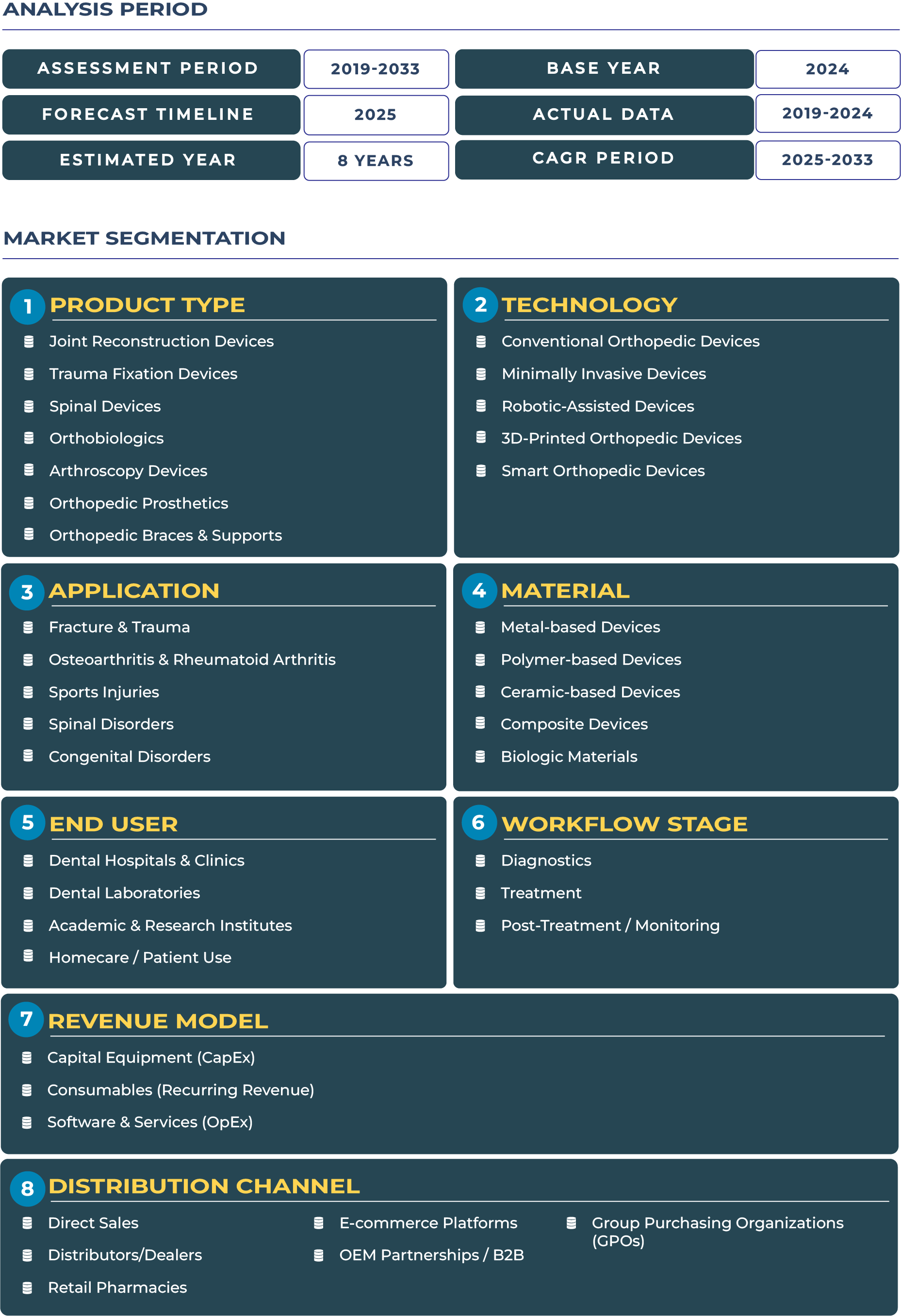Qatar Orthopedic Devices Market Outlook: Mega Projects and Sports Medicine Shaping Future Growth
Qatar orthopedic devices market is intricately tied to the country’s healthcare mega-projects and investments in sports medicine that accelerated in the lead-up to major international events such as the FIFA World Cup 2022. These developments created a surge in new hospital facilities, specialized orthopedic wards, and rehabilitation centers that now serve both local populations and medical tourists. The orthopedic devices industry in Qatar is positioned at an inflection point, with the market valued at USD 20.1 million in 2025 and projected to reach USD 27.5 million by 2033. This measured yet sustained growth reflects not only the nation’s commitment to developing centers of excellence in healthcare but also the rising demand for trauma fixation, arthroscopy, and joint reconstruction devices among patients and athletes. By linking national infrastructure development with advanced medical technology adoption, Qatar is shaping a resilient orthopedic devices ecosystem that balances modernization with accessibility.
Orthopedic Adoption Accelerated by Hospital Mega Projects and Event-Driven Demand
The market outlook for Qatar orthopedic devices sector is reinforced by state-backed healthcare spending and the ambitious hospital expansion program under Ministry of Public Health Qatar. With tertiary care facilities such as Hamad Medical Corporation expanding their orthopedic capabilities, Qatar is strategically investing in advanced devices including spinal implants and orthobiologics. These developments ensure readiness for both population health requirements and international event-driven surges in medical demand. Sports medicine has emerged as a strong driver, as Qatar positions itself as a hub for sports and wellness, with arthroscopy and prosthetic solutions gaining prominence. This integration of healthcare modernization with international sports positioning demonstrates why orthopedic adoption is firmly embedded in Qatar’s national healthcare strategy.
Drivers & Restraints in the Qatar Orthopedic Devices Market
High Healthcare Spending and Specialized Tertiary Centers Powering Market Growth
Qatar has one of the highest per-capita healthcare spends globally, which translates into advanced adoption of premium orthopedic devices. The construction of large-scale tertiary centers and centers of excellence in Doha supports demand for high-value devices, including robotic-assisted surgical systems. Furthermore, Qatar’s growing reputation as a sports medicine hub has increased the demand for trauma fixation devices and arthroscopy systems, particularly in light of the influx of athletes seeking rehabilitation and treatment in the country. These factors collectively reinforce the orthopedic devices landscape and make Qatar a highly attractive market for global medical technology leaders.
Restraints: Small Market Size and Event-Linked Procurement Challenges
Despite strong infrastructure and spending, the orthopedic devices sector in Qatar faces unique limitations. The overall market size remains relatively small compared to neighboring GCC nations, limiting large-scale economies of scale. Additionally, device procurement is often tied to timelines of mega events, leading to irregular purchasing patterns that impact supplier strategies. Competition for skilled medical talent also hampers rapid adoption, as Qatar competes with other regional hubs like the UAE and Saudi Arabia to attract orthopedic specialists. These constraints highlight the structural challenges the orthopedic devices industry must navigate to sustain consistent long-term growth.
Trends & Opportunities: Sports Medicine, Centers of Excellence, and Managed Care Partnerships
Trends: Upgrades to Tertiary Centers and High ASP Device Adoption
A defining trend in the Qatar orthopedic devices market is the rapid upgrading of tertiary centers in Doha, designed to integrate world-class orthopedic surgical units. Centers of excellence are prioritizing advanced prosthetics, spinal implants, and high average selling price (ASP) devices, reflecting Qatar’s focus on premium healthcare delivery. The orthopedic devices ecosystem is also seeing a rise in collaborations between hospitals and international specialists, enhancing the sophistication of treatment options available locally.
Opportunities: Partnerships, Event Readiness, and Training Programs
Significant opportunities exist for global and local players in Qatar orthopedic devices sector. Center-of-excellence partnerships between global device manufacturers and institutions like Hamad Medical Corporation open avenues for cutting-edge research and device adoption. Managed service deals, particularly those designed to ensure readiness for global sporting events, reduce procurement friction and guarantee supply continuity. Training programs for orthopedic surgeons in minimally invasive techniques further strengthen Qatar’s ability to meet rising demand for advanced orthopedic interventions. These opportunities, if effectively leveraged, can further cement Qatar’s role as a regional hub in orthopedic care.
Competitive Landscape: Event-Driven Demand and Partnerships Redefining Orthopedic Strategies in Qatar
The competitive landscape in Qatar is shaped by both global leaders and regional players aligning with the country’s healthcare and sports-driven vision. Companies like Johnson & Johnson MedTech and Smith+Nephew have expanded their presence by offering managed services to tertiary centers and supporting training initiatives for local surgeons. Event-readiness programs, especially around sports tournaments, have pushed companies to develop agile supply chain models that ensure the availability of trauma fixation and arthroscopy devices. Sponsorship of orthopedic training and telemedicine integration are also gaining traction, reinforcing Qatar orthopedic devices sector as an attractive market for long-term investment. The alignment of corporate strategies with national healthcare goals ensures a competitive yet collaborative environment in the orthopedic devices industry.







